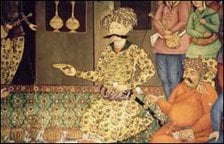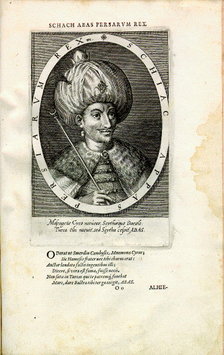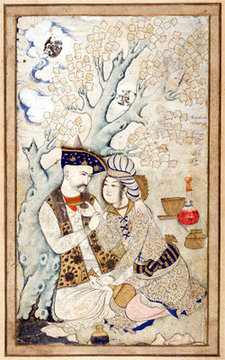Shah Abbas
Shah Abbas was the first Saffavid ruler to achieve a united Persia. He strictly enforced Ithna Ashariya Shi'ism, made Farsi the state language. Although Ismail I (1487-1524)had established the dynasty, Shah Abbas is credited with consolidating its rule. He skillfully used British assistance to solidify Iranian independence from the Sunni Ottomans, although the foothold gained in Iran by the British would ultimately lead to the unpopularity, and downfall, of the last of Iran in 1979, accused of being too Westernized. The British gained ownership of oil rights in 1901 when William Knox D'Arcy, founder of the Anglo-Persian Oil Company, a concession of 480,000 square miles from the Grand Vizier in Teheran at a cost of twenty thousand pounds.
Shah Abbas I (شاه عباس اول) (January 27, 1571-[[January 19, 1629?) was the most eminent ruler of the Safavid Dynasty that ruled Persia (Iran). He was also known as Shah Abbas the Great (شاه عباس بزرگ). In early October, 1588 he became Shah of Iran, by revolting against his father, Mohammad of Safavid, and imprisoning him.
In the midst of general anarchy in Persia, he was proclaimed ruler of Khorasan in 1581, and obtained possession of the Persian throne with the help of Morshed Gholi Ostajlou, whom he later killed in July, 1589. Determined to raise the fallen fortunes of his country, he first directed his efforts against the predatory Uzbeks, who occupied and harassed Khorasan. After a long and severe struggle, he regained Mashhad, defeated them in a great battle near Herat in 1597, and drove them out of his dominions.
He moved his capital from Qazvin to Isfahan in 1592. A few years later, in 1599, the Englishman Sir Robert Shirley directed a major army reform on his behalf. Europeans were happy to ally themselves with the Shah against the Ottomans, whom they both feared and loathed. With his new army, Shah Abbas defeated the Ottoman Turks in 1603, forcing them to give back the territory they had seized, including Baghdad their former, and the Abbasid former capital (now in Iraq). In 1605, following a victory at Basra, he extended his empire beyond the Euphrates; Ottoman Sultan Ahmed I was forced to cede Shirvan and Kurdistan in 1611; in 1615 he killed more than 60,000 Georgians and deported a further 100,000 in Tblisi after a rebellion, the united armies of the Turks and Tatars were completely defeated near Sultanieh in 1618, and Abbas made peace on very favourable terms; and on the Turks renewing the war, Baghdad fell into his hands after a year's siege in 1623. In 1622 he took the island of Hormuz from the Portuguese, by the assistance of the British, and much of its trade was diverted to the town of Bandar Abbas which he had taken from the Portuguese in 1615 and had named after himself.
Abbas' reign, with its military successes and efficient administrative system, raised Iran to the status of a great power. Abbas was a skilled diplomat, tolerant of his Christian subjects in Armenia. He sent Shirley to Italy, Spain and England in order to create a pact against the Ottomans. he curtaield the power of local chiefs, replacing them with centrally appointed governors.
Trade with the West and industry grew. He established a royal monopoly over the silk trade. Isfahan became the center of Safavid architectural achievement, with the mosques Masjed-e Shah and the Sheikh lotf allah mosque and other monuments like the Ali Qapu, the Chehel Sotoun palace, and the Meydan-e Shah. His painting ateliers (of the Isfahan school established under his patronage) created some of the finest art in modern Persian history, by such illustrious painters as Reza Abbasi, Mohammed Qasim and others. Despite the ascetic roots of the Safavid dynasty and the religious injunctions restricting the pleasures lawful to the faithful, the art of Abbas' time denotes a certain relaxation of the strictures. Historian James Saslow interprets the portrait by Muhammad Qasim as showing that the Muslim taboo against wine, as well as that against male intimacy, "were more honored in the breach than in the observance." Contemporary European observers at the Shah's court reflected similarly on prevalent customs. Among them was Thomas Herbert, the nineteen-year-old secretary to the British amabassador, who later related that he saw "Ganymede boys in vests of gold, rich bespangled turbans, and choice sandals, their curled hair dangling about their shoulders, with rolling eyes and vermilion cheeks."
Shah Abbas welcomed foreigners at his court and enjoyed religious discussion. He allowed Christians in his realm to own land and to wear whatever clothes they wanted (elsewhere, Muslims imposed a dress code on non-Muslims). He also build hospitals and put in place other welfare provisons for his subjects. A medical publication from this time lists the instruments available for use in surgery. Some forms of anesthesia were also practiced. The Safavids were descendents of Sheykh Safi od-Din who led had the Sufi order of Sasaviyeh in the 13th century and were also recognized as head, or Pir, of that order. This gave their political authority a religious sanction. However, in Ithna Ashariya Shi'a, no earthly political authority can claim absolute power, since this is exercised by the Hidden Imam (the 12th Imam, al-Madhi, is believed to have been assumed into heaven in the year 939C.E.). Usually, religious scholars (Ulama) claim to represent the Hidden Imam on earth. However, they believed that a just and pious ruler was also necessary to 'carry the sword'. Something of a struggle emerged between the Shah and the Ulama on the question who represented the Imam. Ismail I was widely regarded as murshid-kamil, supreme gude. Shah Abbas ordered the execution or exile of Ulama who did not recognize his religious as well as political supremacy.
When Abbas died, his dominions reached from the Tigris to the Indus River in the Indian Sub-continent. His fame is tarnished, however, by numerous deeds of tyranny and cruelty, particularly against his own family. Afraid of a coup by his family (as he had done to his father), he locked them up in palaces in order to keep them without knowledge of the outside world. This resulted in weak successors. He killed his eldest son, Safi Mirza, and left his throne to his grandson.
Sources
- The Persian Encyclopedia's entries on "Abbas I of Safavid" and "Mohammad of Safavid"
- Iran Chamber
- See also The Three Brothers, or Travels of Sir Anthony, Sir Robert Sherley, etc. (London, 1823); Sir C. R. Markham, General Sketch of the History of Persia (London, 1874).
Credits
New World Encyclopedia writers and editors rewrote and completed the Wikipedia article in accordance with New World Encyclopedia standards. This article abides by terms of the Creative Commons CC-by-sa 3.0 License (CC-by-sa), which may be used and disseminated with proper attribution. Credit is due under the terms of this license that can reference both the New World Encyclopedia contributors and the selfless volunteer contributors of the Wikimedia Foundation. To cite this article click here for a list of acceptable citing formats.The history of earlier contributions by wikipedians is accessible to researchers here:
The history of this article since it was imported to New World Encyclopedia:
Note: Some restrictions may apply to use of individual images which are separately licensed.


